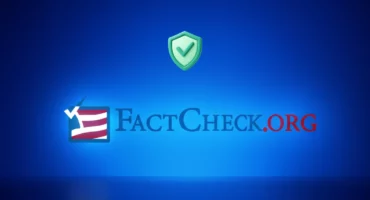Email Spoofing Explained: How to Spot and Protect Yourself
If you could use a time machine and travel back to the early days of email you would see that phishing scams were laughably obvious and cybercriminals hadn’t yet mastered the art of deception. Back then, a spoofed email might say, “Click here to claim your $1,000,000 prize,” complete with glaring typos and suspicious links. Fast forward to today, and the landscape looks dramatically different.
Email spoofing has evolved into a sophisticated threat, fooling even the savviest users. Modern spoofed emails come dressed as trusted brands, colleagues, or even friends, skillfully bypassing filters and luring victims into dangerous traps. What makes this cyber threat even more alarming is its ability to adapt over time — just like a cunning spy learning new tricks with each new mission.
In this article, we’ll take you on a journey through the history of email spoofing, showing how it has progressed from basic phishing attempts to advanced schemes that blend technology and psychological manipulations, and explain how to stay protected these days.

Email spoofing definition
Cybercriminals do email spoofing by sending messages which look like they originate from legitimate sources. Scammers modify a sender’s email address through email protocols to send messages appearing from trusted sources including financial institutions, work colleagues, or popular service providers. In such a way, scammers get your personal information since you believe that email address appears legit and you’re communicating with a legitimate person or organization.
Common types of spoofed emails
There are several types of spoofed emails you may get into your inbox:
- Phishing emails which request your account details through fraudulent tactics. The messages create a feeling of emergency by saying you have to immediately confirm your login credentials, otherwise you will lose access to your profile.
- Messages from “coworkers” or “bosses” asking for urgent action, like wire transfers. This form of social engineering exploits trust in workplace relationships, making it difficult for employees to check the legitimacy of the request and leading to business email compromise (BEC).
- Fake communications from popular online services requesting password resets. You may receive a message that authentic email from forged sender addresses prompting you to update your credentials, pushing you to click on a malicious link that compromises your account.
Needless to say, falling into these traps leads to serious consequences. Let’s discuss the dangers of email address spoofing.
The dangers of email spoofing
The consequences of falling for email spoofing can be severe:
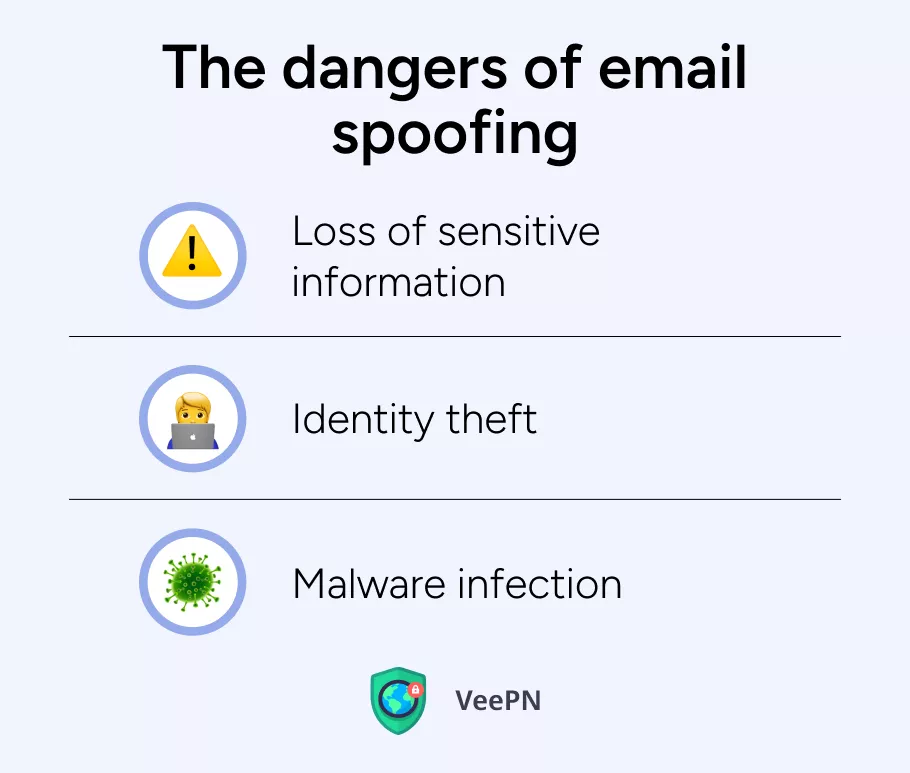
⚠️Loss of sensitive information: When hackers send fake emails, they gain unauthorized access to personal data that they can exploit afterwards.
⚠️Identity theft: Through spoofed emails cybercriminals obtain sensitive data to do identity theft which can cause a serious financial and emotional damage.
⚠️Malware infection: Malicious attachments or links in spoofed emails cause malware installation on victims’ devices leading to additional compromises of personal and corporate system security.
Being aware of spoofed email addresses detection becomes essential. This article will discuss the main indicators of spoofed email communications.
How to recognize spoofed emails
Recognizing spoofed emails requires vigilance:
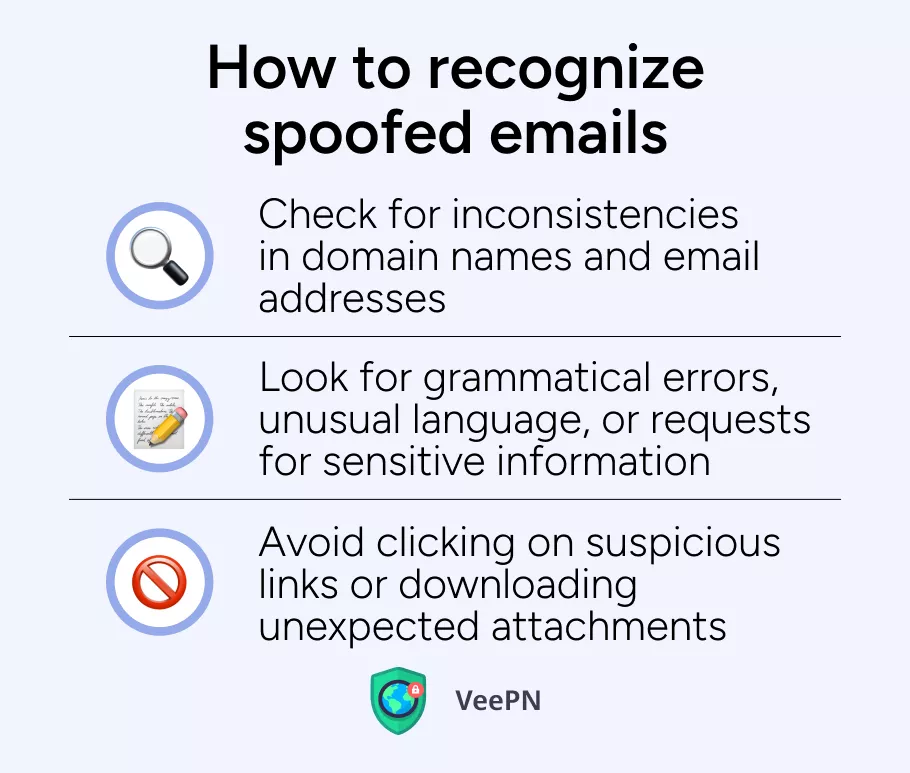
🚩Check for inconsistencies in domain names and email addresses. Always verify the sender’s address and look for subtle misspellings or unusual domain names.
🚩Look for grammatical errors, unusual language, or requests for sensitive information. Legitimate organizations usually communicate clearly and professionally without any mistakes in their grammar.
🚩Avoid clicking on suspicious links or downloading unexpected attachments. Hover over links to see their true destination before clicking.
Knowing how to detect spoofed emails is obviously good, but how do you defend yourself against them?
Best practices of email spoofing prevention
To prevent email address spoofing attack, take the following proactive measures:
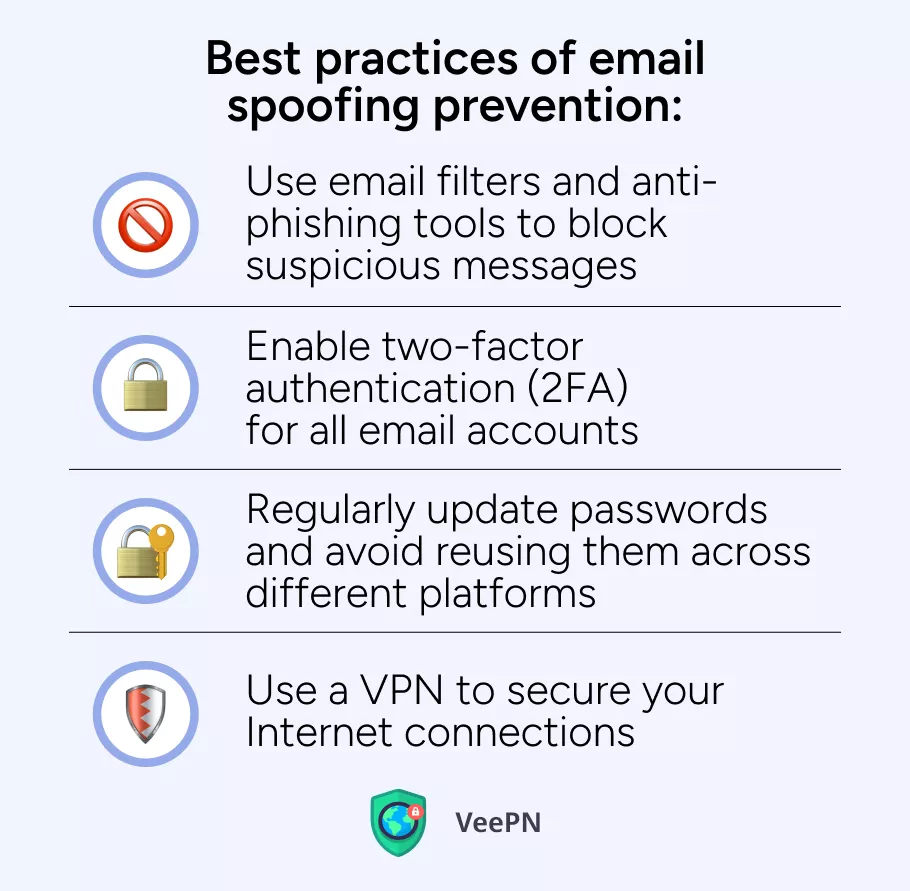
🪬Use email filters and anti-phishing tools. Email filters together with anti-phishing tools help stop suspicious messages. The standard capabilities of most email platforms include tools which assist users in both detecting and stopping phishing attempts as well as basic email authentication protocols and domain based message authentication.
🪬Enable two-factor authentication (2FA). All email accounts should use two-factor authentication (2FA) because this security feature establishes multiple authentication steps that protect against unauthorized access.
🪬Regularly update passwords and avoid reusing them across. Update your passwords on a regular basis and create different passwords for each separate platform you use. Your digital security requires strong unique passwords which you should refresh at least twice per year for each of your accounts.
🪬Use a virtual private network (VPN) app. Your Internet connections need protection through the use of a VPN. The encryption capabilities of VPN will protect your Internet traffic from unauthorized access even when you deliberately click on phishing links. Free Avoid free VPNs because they lack strong encryption protocols needed for protection of your connections. Instead use VeePN that delivers both top-notch encryption and numerous sophisticated security features.
How VeePN can help with email spoofing protection
VeePN offers a range of features that can enhance your online security:
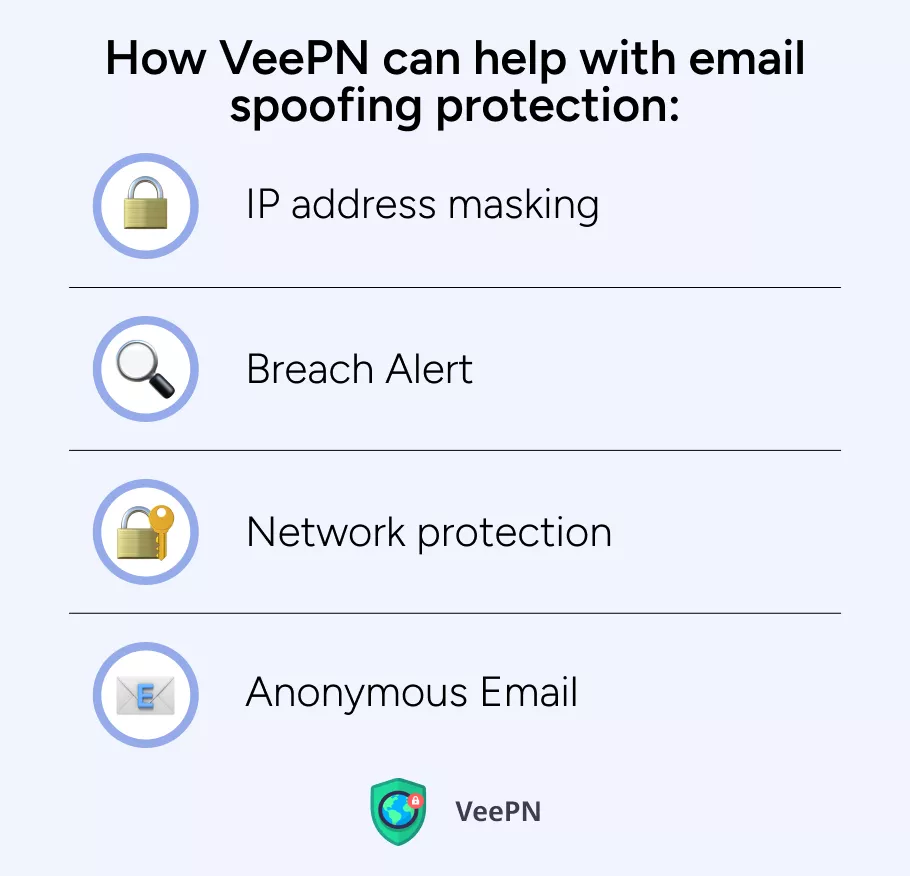
🛡️IP address masking: By hiding your real IP address, VeePN makes it harder for cybercriminals to target you with spoofed emails.
🛡️Breach Alert: This feature will notify you instantly when your sensitive information leaks, so you can take preventive measures to protect yourself.
🛡️Network protection: With VeePN, you can encrypt your Internet connection on public Wi-Fi networks with the best protocol, minimizing exposure to potential email spoofing attacks.
🛡️Anonymous Email: You can create a fake email address which will forward messages to your real one. In such a way, you won’t show your real email address and avoid being attacked with spoofed emails.
You can use one VeePN subscription for up to 10 different devices simultaneously. Download VeePN today and enjoy a 30-day money-back guarantee!
FAQ
The protection against spoofed emails requires implementing sender policy framework SPF, DKIM, and DMARC protocols which both verify email sender authenticity and establish rules for unidentified messages. To effectively block suspicious email messages you should learn advanced email filtering techniques while using these protocols with education programs. Additional spoofed email prevention methods you can find in this article.
Through email spoofing an attacker modifies the displayed sender address to impersonate another trusted person who intends to trick their recipient. At the same time, the broad social engineering tactic known as phishing uses fake emails from trusted sources which trick users into providing sensitive information including passwords and financial details. Phishing attacks incorporate spoofing as one of their techniques but may also use fake websites and phone calls for user deception.
Email spoofing is possible to prevent, but there are no absolute chances to do so because attackers just need your email address. Email authentication through SPF and DKIM and DMARC protocols enables you to validate legitimate messages. Analysis of DMARC reports lets you detect spoofing attempts while building stronger protection measures.
By using a VPN you can secure your email account via encrypted connections that prevent email spoofing attacks when connecting over insecure or public networks. Thanks to VPN encryption, attackers cannot intercept or modify email traffic so man-in-the-middle attacks become almost impossible. Read this article to learn how VPN protects your email security.
VeePN is freedom
Download VeePN Client for All Platforms
Enjoy a smooth VPN experience anywhere, anytime. No matter the device you have — phone or laptop, tablet or router — VeePN’s next-gen data protection and ultra-fast speeds will cover all of them.
Download for PC Download for Mac IOS and Android App
IOS and Android App
Want secure browsing while reading this?
See the difference for yourself - Try VeePN PRO for 3-days for $1, no risk, no pressure.
Start My $1 TrialThen VeePN PRO 1-year plan



